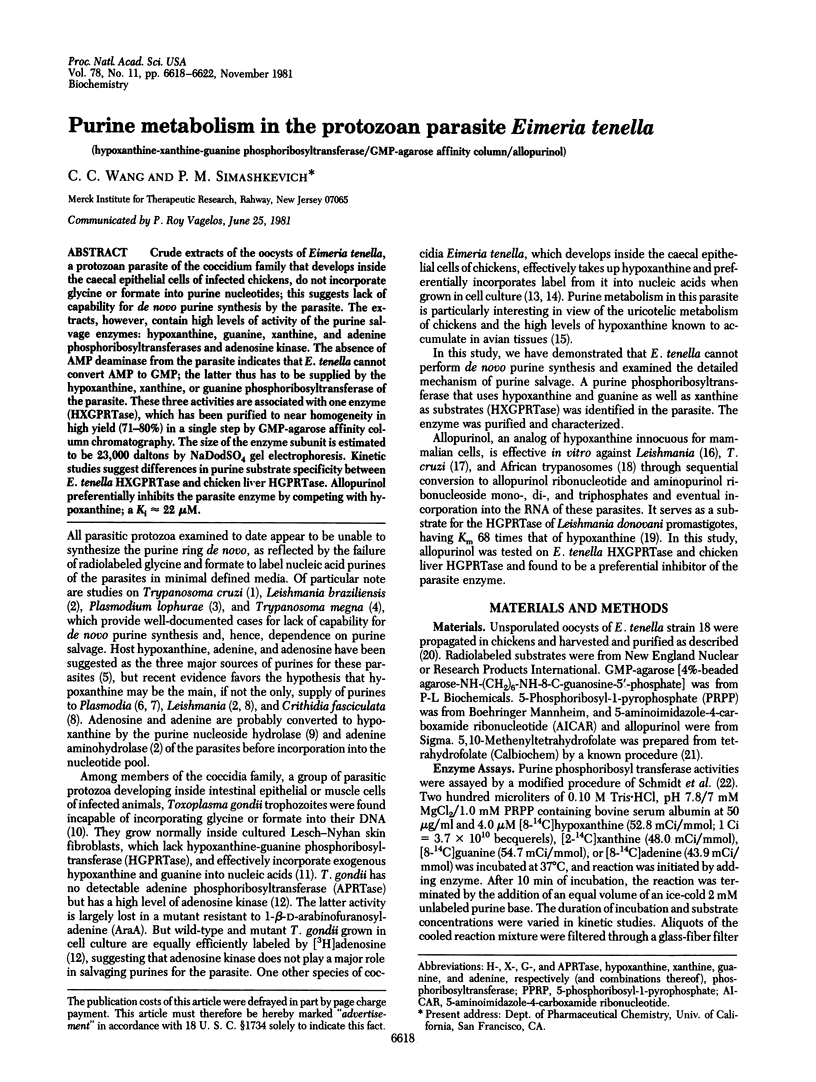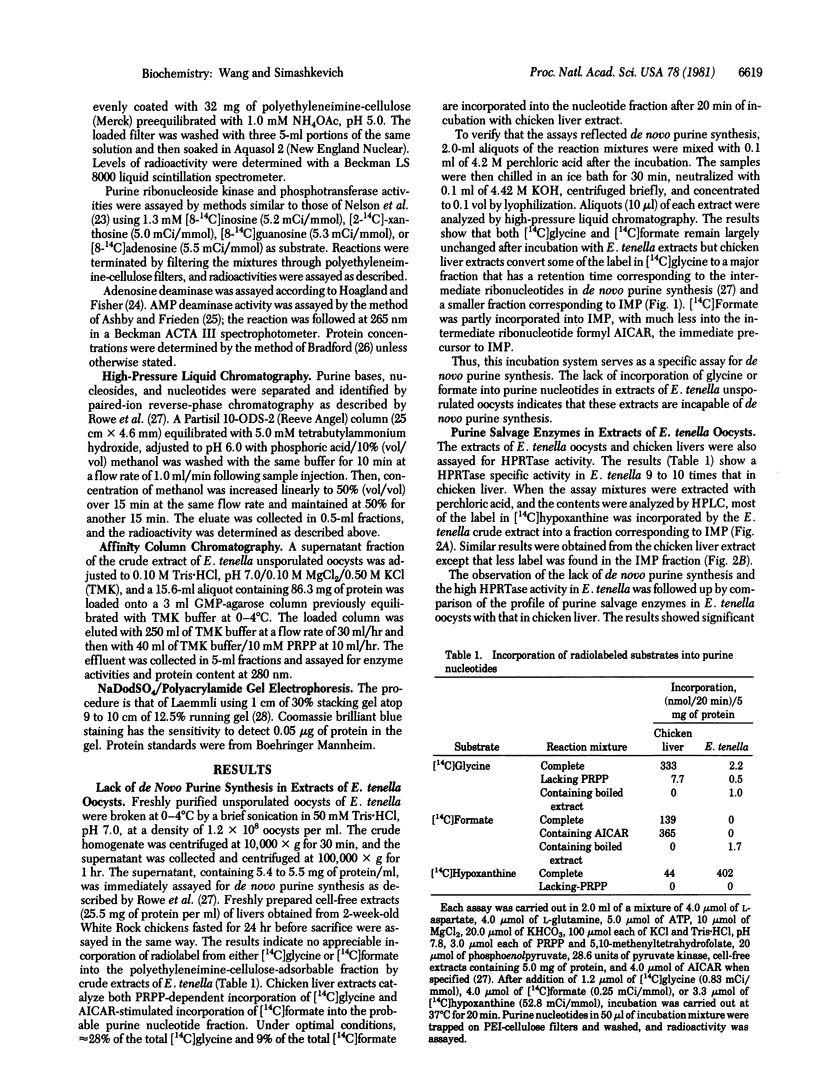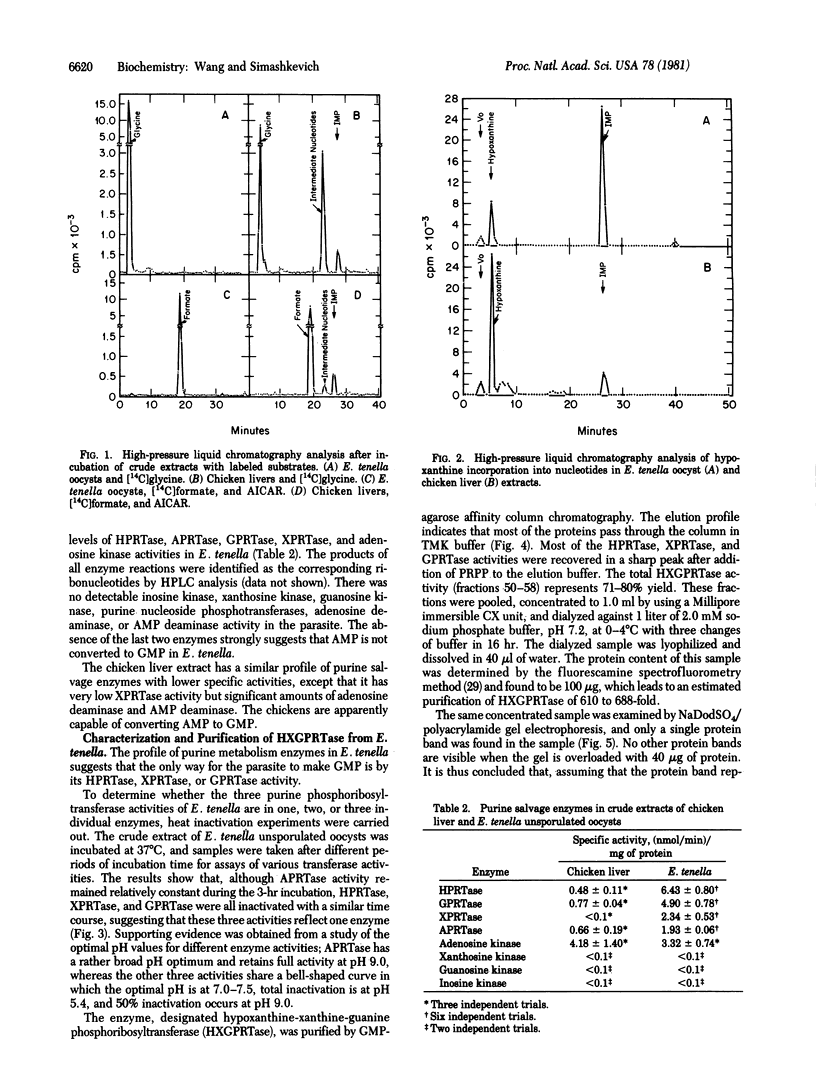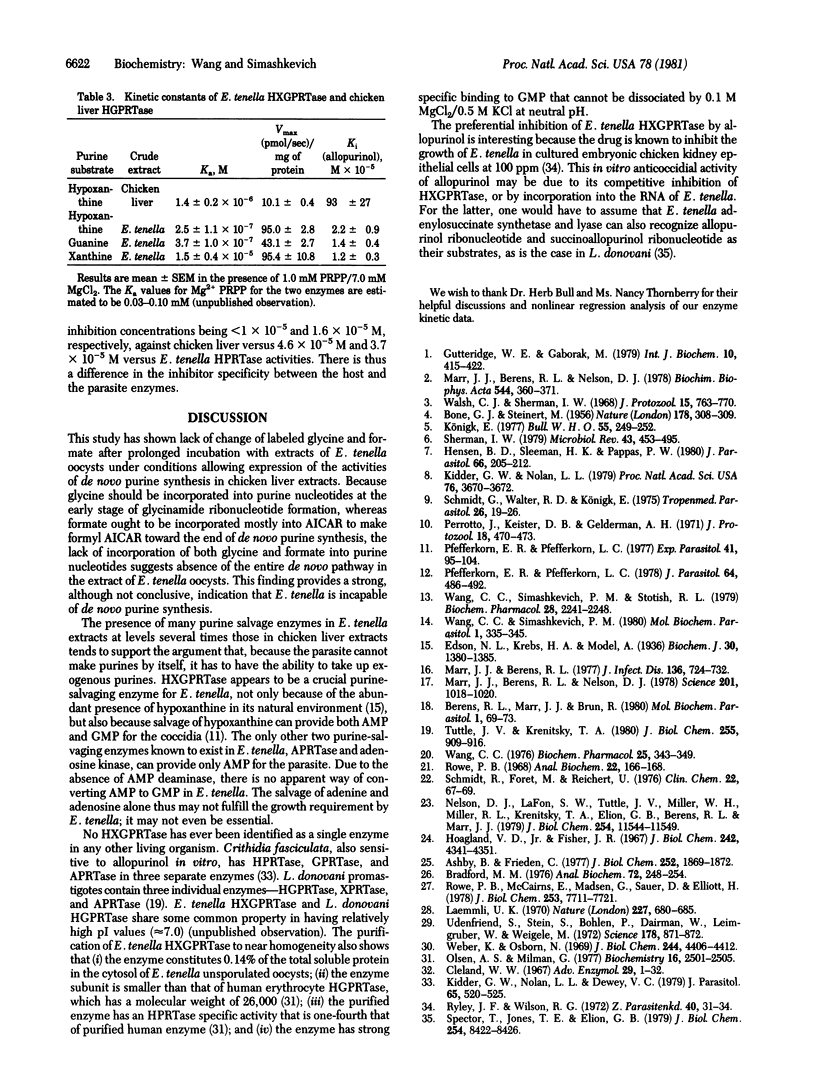Abstract
Crude extracts of the oocysts of Eimeria tenella, a protozoan parasite of the coccidium family that develops inside the caecal epithelial cells of infected chickens, do not incorporate glycine or formate into purine nucleotides; this suggests lack of capability for de novo purine synthesis by the parasite. The extracts, however, contain high levels of activity of the purine salvage enzymes: hypoxanthine, guanine, xanthine, and adenine phosphoribosyltransferases and adenosine kinase. The absence of AMP deaminase from the parasite indicates that E. tenella cannot convert AMP to GMP; the latter thus has to be supplied by the hypoxanthine, xanthine, or guanine phosphoribosyltransferase of the parasite. These three activities are associated with one enzyme (HXGPRTase), which has been purified to near homogeneity in high yield (71-80%) in a single step by GMP-agarose affinity column chromatography. The size of the enzyme subunit is estimated to be 23,000 daltons by NaDodSO4 gel electrophoresis. Kinetic studies suggest differences in purine substrate specificity between E. tenella HXGPRTase and chicken liver HGPRTase. Allopurinol preferentially inhibits the parasite enzyme by competing with hypoxanthine; a Ki approximately 22 microM.
Full text
PDF




Images in this article
Selected References
These references are in PubMed. This may not be the complete list of references from this article.
- Ashby B., Frieden C. Interaction of AMP-aminohydrolase with myosin and its subfragments. J Biol Chem. 1977 Mar 25;252(6):1869–1872. [PubMed] [Google Scholar]
- BONE G. J., STEINERT M. Isotopes incorporated in the nucleic acids of Trypanosoma mega. Nature. 1956 Aug 11;178(4528):308–309. doi: 10.1038/178308a0. [DOI] [PubMed] [Google Scholar]
- Berens R. L., Marr J. J., Brun R. Pyrazolopyrimidine metabolism in African trypanosomes: metabolic similarities to Trypanosoma cruzi and Leishmania spp. Mol Biochem Parasitol. 1980 Apr;1(2):69–73. doi: 10.1016/0166-6851(80)90001-8. [DOI] [PubMed] [Google Scholar]
- Bradford M. M. A rapid and sensitive method for the quantitation of microgram quantities of protein utilizing the principle of protein-dye binding. Anal Biochem. 1976 May 7;72:248–254. doi: 10.1006/abio.1976.9999. [DOI] [PubMed] [Google Scholar]
- Cleland W. W. The statistical analysis of enzyme kinetic data. Adv Enzymol Relat Areas Mol Biol. 1967;29:1–32. doi: 10.1002/9780470122747.ch1. [DOI] [PubMed] [Google Scholar]
- Edson N. L., Krebs H. A., Model A. The synthesis of uric acid in the avian organism: hypoxanthine as an intermediary metabolite. Biochem J. 1936 Aug;30(8):1380–1385. doi: 10.1042/bj0301380. [DOI] [PMC free article] [PubMed] [Google Scholar]
- Gutteridge W. E., Gaborak M. A re-examination of purine and pyrimidine synthesis in the three main forms of Trypanosoma cruzi. Int J Biochem. 1979;10(5):415–422. doi: 10.1016/0020-711x(79)90065-x. [DOI] [PubMed] [Google Scholar]
- Hansen B. D., Sleeman H. K., Pappas P. W. Purine base and nucleoside uptake in Plasmodium berghei and host erythrocytes. J Parasitol. 1980 Apr;66(2):205–212. [PubMed] [Google Scholar]
- Hoagland V. D., Jr, Fisher J. R. Purification and properties of chicken duodenal adenosine deaminase. J Biol Chem. 1967 Oct 10;242(19):4341–4351. [PubMed] [Google Scholar]
- Kidder G. W., Nolan L. L. Adenine aminohydrolase: occurrence and possible significance in trypanosomid flagellates. Proc Natl Acad Sci U S A. 1979 Aug;76(8):3670–3672. doi: 10.1073/pnas.76.8.3670. [DOI] [PMC free article] [PubMed] [Google Scholar]
- Kidder G. W., Nolan L. L., Dewey V. C. The purine phosphoribosyltransferases of Crithidia fasciculata. J Parasitol. 1979 Aug;65(4):520–525. [PubMed] [Google Scholar]
- Königk E. Salvage syntheses and their relationship to nucleic acid metabolism. Bull World Health Organ. 1977;55(2-3):249–252. [PMC free article] [PubMed] [Google Scholar]
- Laemmli U. K. Cleavage of structural proteins during the assembly of the head of bacteriophage T4. Nature. 1970 Aug 15;227(5259):680–685. doi: 10.1038/227680a0. [DOI] [PubMed] [Google Scholar]
- Marr J. J., Berens R. L. Antileishmanial effect of allopurinol. II. Relationship of adenine metabolism in Leishmania species to the action of allopurinol. J Infect Dis. 1977 Dec;136(6):724–732. doi: 10.1093/infdis/136.6.724. [DOI] [PubMed] [Google Scholar]
- Marr J. J., Berens R. L., Nelson D. J. Antitrypanosomal effect of allopurinol: conversion in vivo to aminopyrazolopyrimidine nucleotides by Trypanosoma curzi. Science. 1978 Sep 15;201(4360):1018–1020. doi: 10.1126/science.356267. [DOI] [PubMed] [Google Scholar]
- Marr J. J., Berens R. L., Nelson D. J. Purine metabolism in Leishmania donovani and Leishmania braziliensis. Biochim Biophys Acta. 1978 Dec 1;544(2):360–371. doi: 10.1016/0304-4165(78)90104-6. [DOI] [PubMed] [Google Scholar]
- Nelson D. J., LaFon S. W., Tuttle J. V., Miller W. H., Miller R. L., Krenitsky T. A., Elion G. B., Berens R. L., Marr J. J. Allopurinol ribonucleoside as an antileishmanial agent. Biological effects, metabolism, and enzymatic phosphorylation. J Biol Chem. 1979 Nov 25;254(22):11544–11549. [PubMed] [Google Scholar]
- Olsen A. S., Milman G. Human hypoxanthine phosphoribosyltransferase. Purification and properties. Biochemistry. 1977 May 31;16(11):2501–2505. doi: 10.1021/bi00630a029. [DOI] [PubMed] [Google Scholar]
- Perrotto J., Keister D. B., Gelderman A. H. Incorporation of precursors into Toxoplasma DNA. J Protozool. 1971 Aug;18(3):470–473. doi: 10.1111/j.1550-7408.1971.tb03356.x. [DOI] [PubMed] [Google Scholar]
- Pfefferkorn E. R., Pfefferkorn L. C. The biochemical basis for resistance to adenine arabinoside in a mutant of Toxoplasma gondii. J Parasitol. 1978 Jun;64(3):486–492. [PubMed] [Google Scholar]
- Pfefferkorn E. R., Pfefferkorn L. C. Toxoplasma gondii: specific labeling of nucleic acids of intracellular parasites in Lesch-Nyhan cells. Exp Parasitol. 1977 Feb;41(1):95–104. doi: 10.1016/0014-4894(77)90134-5. [DOI] [PubMed] [Google Scholar]
- Rowe P. B. A simple method for the synthesis of N5,N10-methenyltetrahydrofolic acid. Anal Biochem. 1968 Jan;22(1):166–168. doi: 10.1016/0003-2697(68)90271-6. [DOI] [PubMed] [Google Scholar]
- Rowe P. B., McCairns E., Madsen G., Sauer D., Elliott H. De novo purine synthesis in avian liver. Co-purification of the enzymes and properties of the pathway. J Biol Chem. 1978 Nov 10;253(21):7711–7721. [PubMed] [Google Scholar]
- Ryley J. F., Wilson R. G. Growth factor antagonism studies with Coccidia in tissue culture. Z Parasitenkd. 1972;40(1):31–34. doi: 10.1007/BF00329613. [DOI] [PubMed] [Google Scholar]
- Schmidt G., Walter R. D., Königk E. A purine nucleoside hydrolase from Trypanosoma gambiense, purification and properties. Tropenmed Parasitol. 1975 Mar;26(1):19–26. [PubMed] [Google Scholar]
- Schmidt R., Forêt M., Reichert U. Improved microscale assay for purine phosphoribosyltransferase activities. Clin Chem. 1976 Jan;22(1):67–69. [PubMed] [Google Scholar]
- Sherman I. W. Biochemistry of Plasmodium (malarial parasites). Microbiol Rev. 1979 Dec;43(4):453–495. doi: 10.1128/mr.43.4.453-495.1979. [DOI] [PMC free article] [PubMed] [Google Scholar]
- Spector T., Jones T. E., Elion G. B. Specificity of adenylosuccinate synthetase and adenylosuccinate lyase from Leishmania donovani. Selective amination of an antiprotozoal agent. J Biol Chem. 1979 Sep 10;254(17):8422–8426. [PubMed] [Google Scholar]
- Tuttle J. V., Krenitsky T. A. Purine phosphoribosyltransferases from Leishmania donovani. J Biol Chem. 1980 Feb 10;255(3):909–916. [PubMed] [Google Scholar]
- Udenfriend S., Stein S., Böhlen P., Dairman W., Leimgruber W., Weigele M. Fluorescamine: a reagent for assay of amino acids, peptides, proteins, and primary amines in the picomole range. Science. 1972 Nov 24;178(4063):871–872. doi: 10.1126/science.178.4063.871. [DOI] [PubMed] [Google Scholar]
- Walsh C. J., Sherman I. W. Purine and pyrimidine synthesis by the avian malaria parasite, Plasmodium lophurae. J Protozool. 1968 Nov;15(4):763–770. doi: 10.1111/j.1550-7408.1968.tb02209.x. [DOI] [PubMed] [Google Scholar]
- Wang C. C., Simashkevich P. M. A comparative study of the biological activities of arprinocid and arprinocid-1-N-oxide. Mol Biochem Parasitol. 1980 Oct;1(6):335–345. doi: 10.1016/0166-6851(80)90051-1. [DOI] [PubMed] [Google Scholar]
- Wang C. C., Simashkevich P. M., Stotish R. L. Mode of anticoccidial action of arprinocid. Biochem Pharmacol. 1979 Aug 1;28(15):2241–2248. doi: 10.1016/0006-2952(79)90685-3. [DOI] [PubMed] [Google Scholar]
- Weber K., Osborn M. The reliability of molecular weight determinations by dodecyl sulfate-polyacrylamide gel electrophoresis. J Biol Chem. 1969 Aug 25;244(16):4406–4412. [PubMed] [Google Scholar]




